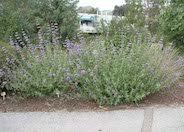
Common name: Purple or Gray Sage
Botanical name: Salvia leucophylla
The Purple Sage is an evergreen shrub that grows 2'-3' tall by 5'-6' wide. It has white tomentose stems and leaves and light lavender purple flowers blooming in late spring. This shrub tolerates heat and drought. The purple sage is a CA native, preferring full sun. Do not overwater. This Sage is great for covering difficult slopes. Foliage is aromatic.
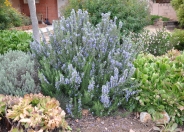
Common name: Tuscan Blue Upright Rosemary
Botanical name: Rosmarinus officinalis 'Tuscan Blue'
'Tuscan Blue' is an upright shrub that grows 4'-6' tall and wide. It has olive green, needle-like, small, aromatic leaves and bright showy lavender-blue flowers that are larger than other cultivars, blooming in winter and spring. This shrub is drought tolerant once it's established, preferring full sun and well draining soil.
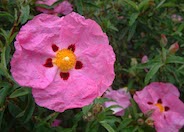
Common name: Purple Rockrose
Botanical name: Cistus x purpureus
Purple or Orchid Rockrose is an evergreen shrub growing to 4' tall and wide, often shorter in stressful situations. The rosy-crimson flowers to 3" wide exhibit a dark purple blotch at the base of each petal, and bloom early to mid-summer. The flowers also feature a contrasting yellow cluster of stamens in the center. It does well in salt spray and cool winds. It is relatively long-lived, tolerant of heat and aridity as well as accepting many soil conditions. -Native Sons Nursery
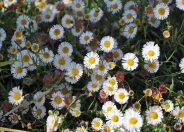
Common name: Santa Barbara Daisy, Mexican Daisy
Botanical name: Erigeron karvinskianus
This low mounding perennial is used as a ground cover since it reaches 2' tall and spreads 5'. It has fine textured, green leaves and white to pinkish, daisy-like flowers with gold centers that bloom spring through fall in coastal areas. In warmer, inland areas, the plant appears to be semi-dormant but will perk up as soon as the weather starts to cool. Control its growth with watering as it can be invasive in some areas. It looks best in full sun in coastal areas but prefers afternoon shade in warm, inland areas. It attracts bees. This is a great plant for rock gardens, planters, containers, or spilling over walls.
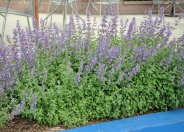
Common name: Catmint
Botanical name: Nepeta x faassenii
Nepeta faassenii makes soft, grey-green, undulating mounds to 1.5' high in bloom, spreading 3'-4' wide. The small leaves are attractive to cats. This perennial has lavender blue flowers in summer. Catmint can be planted in sun or shade and needs medium amount of water. Prune spent flowers to encourage more blooms.